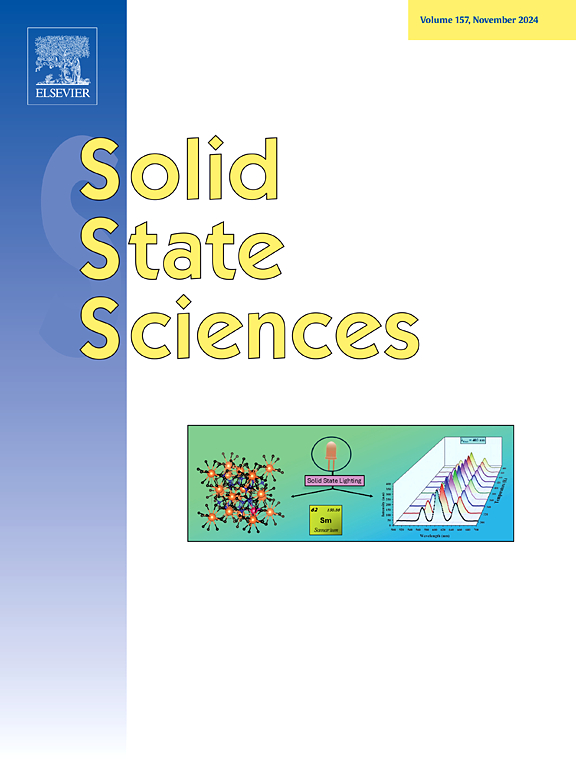Comparing study of electrical transport properties of bulk Y-123 synthesized by modified wet and dry synthesis methods
IF 3.4
3区 化学
Q2 CHEMISTRY, INORGANIC & NUCLEAR
引用次数: 0
Abstract
This qualitative comparative study discusses the fabrication of bulk YBa2Cu3O7-δ (Y-123) using various modified synthesis methods, including thermal treatment, solid-state, and thermal decomposition methods in ambient conditions. The comparison analysis yielded the following findings for all synthesis methods: i) good orthorhombicity value of crystal structure (∼0.008) (ii) oxygen content close to theoretical value (∼6.8) (iii) presence of non-superconducting phases such as Y2BaCuO5 (Y-211), BaCuO2 and CuO (iv) slightly varying of Tc-onset value, ∼92 K and (v) Thermal treatment produced a sharp transition width of temperatures, ΔTc (3.2 K), while the decomposition method resulted in sharp transition widths of mean field temperatures, such as ΔTconset−MF (1.5 K), with the highest composition of the Y-123 phase (98.3 %). Additionally, the surface morphology for all synthesis methods showed different trends in compactness. The ratio of the elements contained Y:Ba:Cu in all specimens was close to the ratio of 1:2:3. The significance of promptly grinding and subjecting to a brief heat treatment process for producing high-quality Y-123 materials is emphasized in this relative analysis. The thermal decomposition method targets a novel and advanced modified dry synthesis method to prepare superior high-temperature superconductors, especially Y-123, with cost-effectiveness and time-saving benefits, while also preserving environmentally friendly practices.

改性湿法和干法合成体Y-123的电输运性质比较研究
本定性比较研究讨论了在常温条件下,采用热处理、固相和热分解等多种改性合成方法制备YBa2Cu3O7-δ (Y-123)体的方法。通过对比分析,各合成方法的结果如下:i)良好的晶体结构正交性值(~ 0.008)(ii)氧含量接近理论值(~ 6.8)(iii)存在Y2BaCuO5 (Y-211)、BaCuO2和CuO等非超导相(iv) Tc-onset值变化不大,~ 92 K和(v)热处理产生了温度的急剧转变宽度,ΔTc (3.2 K),而分解方法产生了平均场温度的急剧转变宽度,ΔTconset−MF (1.5 K)。其中Y-123相含量最高(98.3%)。此外,各种合成方法的表面形貌呈现出不同的致密性趋势。所有样品中所含元素Y:Ba:Cu的比值接近1:2:3。在此分析中,强调了及时磨削和采用简短热处理工艺对生产高质量Y-123材料的重要性。热分解方法的目标是一种新颖和先进的改性干法合成方法,以制备优异的高温超导体,特别是Y-123,具有成本效益和节省时间的好处,同时也保持了环境友好的做法。
本文章由计算机程序翻译,如有差异,请以英文原文为准。
求助全文
约1分钟内获得全文
求助全文
来源期刊

Solid State Sciences
化学-无机化学与核化学
CiteScore
6.60
自引率
2.90%
发文量
214
审稿时长
27 days
期刊介绍:
Solid State Sciences is the journal for researchers from the broad solid state chemistry and physics community. It publishes key articles on all aspects of solid state synthesis, structure-property relationships, theory and functionalities, in relation with experiments.
Key topics for stand-alone papers and special issues:
-Novel ways of synthesis, inorganic functional materials, including porous and glassy materials, hybrid organic-inorganic compounds and nanomaterials
-Physical properties, emphasizing but not limited to the electrical, magnetical and optical features
-Materials related to information technology and energy and environmental sciences.
The journal publishes feature articles from experts in the field upon invitation.
Solid State Sciences - your gateway to energy-related materials.
 求助内容:
求助内容: 应助结果提醒方式:
应助结果提醒方式:


